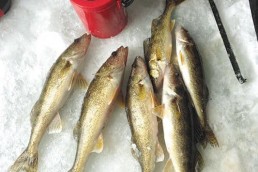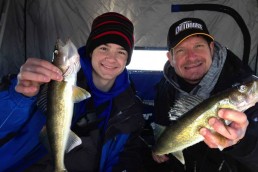Cake and Ice Cream Recipe for December Walleyes
SHARE THIS POST
Current, walleyes, saugers and jigs all fit together like cake and ice cream. The real key to catching river fish is to completely understand how to read the current, the conditions and learn where the walleyes might be holding.
Rivers are not as weather-dependent as a lake, though. And a river’s current doesn’t seem to affect walleyes when stronger cold fronts roll through in winter. And the first cold snap of November and December is a great time to get out and fish the open water of rivers. There’s always a line of boats on the launch ramps during spring and summer, but this is the time of year when many anglers are hanging up their rods for guns. Some of the best fishing of the year is right now and you will often have the best spots all to yourself.
Jig-fishing tactics will catch fish right through ice-up. The current always dictates where the fish are going to be. What you are looking for is slack-water areas, which are common on rivers.
As water temperatures drop and the days get shorter, walleyes and saugers will move from their summer spots and begin migrating upstream. Dams or fast rapids will eventually stop or slow down their movement. They will spend the coldest months of winter in relatively deep water near areas where they eventually spawn in the spring. Walleyes will rest wherever they can to escape the current. Neckdowns, where the current increases, are often good spots to check out. Walleyes must make their way through them and tend to hold just before and after neckdown locations.
Another excellent late-fall fishing spot where walleyes concentrate are on river bends. Study your river map and circle the first set of sharp river bends above or below long, straight parts of the river. Slack water is created by these river bends.
Jig, line selection
Light is often right when it comes to selecting the size of jig you are about to use. Pick out a jig that has just enough weight to feel the jig as it hits the bottom. Faster current and/or a stiff wind will cause you to use a heavier jig. Always maintain good control of your jig and keep track of where it is. You’re wasting your time if you are just guessing. If you don’t know you’re on the bottom, then increase the weight of your jig by 1/8 ounce until you know you’re on the bottom.
Are you enjoying this post?
You can be among the first to get the latest info on where to go, what to use and how to use it!
We recommend using a super-braided line, such as TUF Line XP, on spinning equipment. Ten-pound-test TUF Line XP has incredible strength combined with the diameter of 3-pound-test monofilament. The thin diameter of the braided line allows less drag against the current as you slip your boat downstream, therefore you don’t need as much weight on your jig to stay vertical. Along with the “no-stretch” properties of the TUF Line, you can feel the slightest bite. We recommend using a high-vis. line, which allows you to watch your line. The best jig anglers are all line-watchers. This will tell you if you are on the bottom or if you have a bite.
Dressing your jig with some sort of plastic or live bait has been successful over the years. Try using a more aggressive jigging motion at the beginning, but always keep trying different actions and colors.
Trolling on
A critical skill for being successful on a river is mastering the art of using your bow-mounted trolling motor. Vertical jigging and slipping with the current are important boat-control techniques, which require an electric, bow-mounted trolling motor.
We like to use a technique called “line chasing,” a skill requiring making slight adjustments to your boat speed and direction. The overall objective is to keep your line directly beneath you no matter which way the wind is blowing or how fast the current might be. Start by allowing your boat to drift along a current break and drop your jig down. Then just follow your jig as you lift and drop. Pulse your trolling motor to keep your jig vertical. Line chasing keeps this technique simple and easy to master.
Keep an eye on your sonar and GPS as you drift over areas where you have caught fish, and mark your waypoints when you do catch one. These waypoints will start to tell you where and why the fish are where they are. Fish often congregate on specific spots in a river, such as eddies, rock piles or depressions, so watch your electronics for changes in depth or hardness, which also help you to pinpoint fish location. The transition between the soft and the hard bottom, or slight depth changes, will concentrate fish.
Start with shallow drifts in order to find the more active fish. By targeting good-looking current breaks, your jig will soon tell you if they’re there. So don’t put away your boat for the winter quite yet. Late fall might just become one of your favorite times of the year on a river.
MWO
SHARE THIS POST
Did you enjoy this post?
You can be among the first to get the latest info on where to go, what to use and how to use it!
Ted Takasaki
Ted Takasaki is an International Fishing Hall of Fame professional angler who has been featured in many national outdoor magazines and television shows. Takasaki has appeared in front of thousands of angling enthusiasts and is considered one of America’s top walleye and multispecies anglers. Follow him on his Facebook page.



